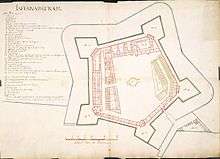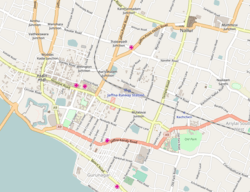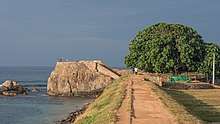Jaffna Fort
Jaffna Fort (Tamil: யாழ்ப்பாணக் கோட்டை, romanized: Yāḻppāṇak Kōṭṭai; Sinhala: යාපනය බලකොටුව Yapanaya Balakotuwa) is a fort built by the Portuguese at Jaffna, Sri Lanka in 1618 under Phillippe de Oliveira following the Portuguese invasion of Jaffna. The fort is located near the coastal village of Gurunagar. Due to numerous miracles attributed to the statue of Virgin Mary in the church nearby, the fort was named as Fortress of Our Lady of Miracles of Jafanapatão (Fortaleza de Nossa Senhora dos Milagres de Jafanapatão). It was captured by the Dutch under Rijcklof van Goens in 1658 who expanded it. In 1795, it was taken over by the British, and remained under the control of a British garrison till 1948. As the only large military fort in the country, due to the presence of only government and military buildings within its ramparts, it was garrisoned by a detachment of the Ceylon Army.

| Jaffna Fort | |
|---|---|
| Part of Jaffna | |
| Jaffna, Sri Lanka | |
.jpg) Entrance of Jaffna Fort that was originally built by the Portuguese and renovated by the Dutch on 1680. | |
 Jaffna Fort | |
| Coordinates | |
| Type | Defense fort |
| Site information | |
| Controlled by | Government of Sri Lanka |
| Open to the public | Yes |
| Condition | Renovated |
| Site history | |
| Built | 1625 |
| Built by | Portuguese and Dutch |
| In use | 1625 - |
| Materials | Granite Stones |
| Battles/wars | Many |
| Garrison information | |
| Occupants | Administration of Sri Lanka |
With the onset of the Sri Lankan Civil War it came under siege on several occasions and was the scene of pitched battles. From 1985 to 1995 it was under the control of the LTTE during this time the LTTE destroyed several of key features to stop the Army getting control due to the site being used to stage attacks but it was recaptured by the Sri Lanka Army in 1995 after a 50-day siege during Operation Riviresa. It was also vandalised by locals to rebuild houses damaged from the war . Today it remains garrisoned by a detachment of the Sri Lanka Army with limited access to visitors and is being renovated with Dutch funding.[1]
Buildings inside the fort include the Governor's residence (King's House), Queen's House, Kruys Church, the Garrison Parade Ground, Police quarters and several buildings from the Portuguese era.
References
- "Sri Lanka fort: Out of the rubble". gulfnews.com. Retrieved 1 September 2016.
_fort.jpg)
